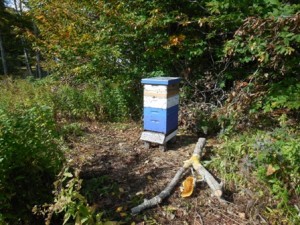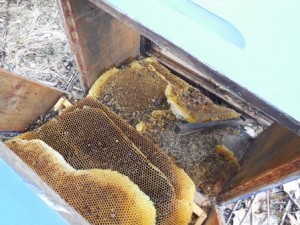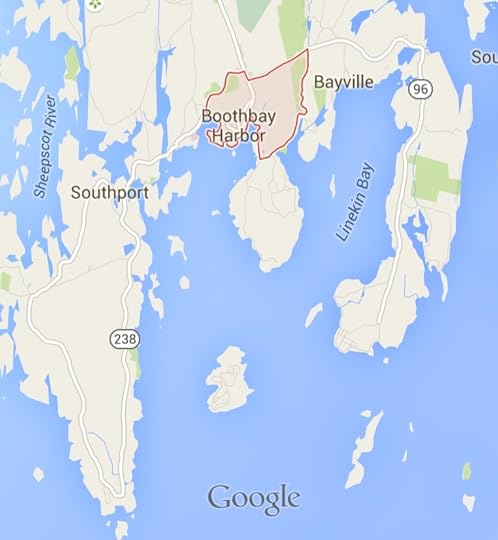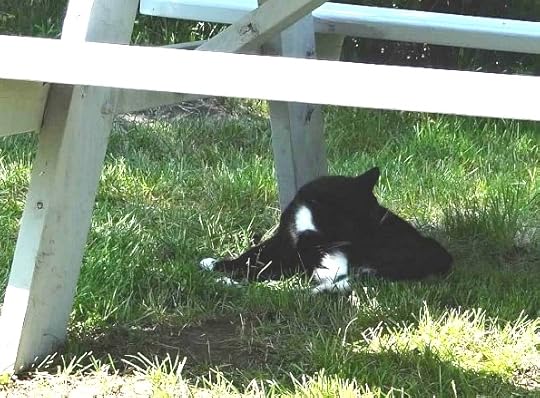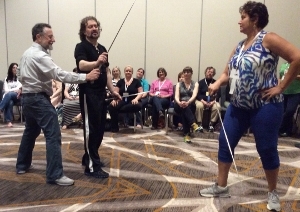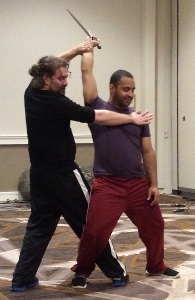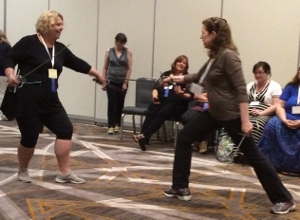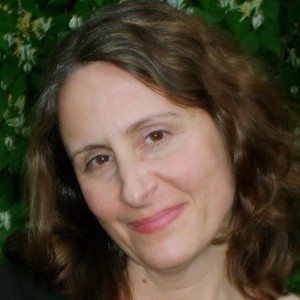Kathy Lynn Emerson's Blog, page 101
July 13, 2015
What the heck is Camel-Nosing?
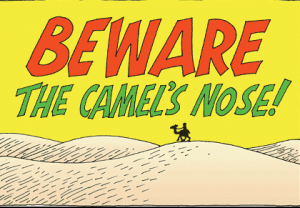 Kate Flora here, hoping you are wondering: So what the heck is “camel-nosing?” Everyone has heard the old Arab story about the camel trying to get into the tent on a cold night, right? And according to Wikipedia:
Kate Flora here, hoping you are wondering: So what the heck is “camel-nosing?” Everyone has heard the old Arab story about the camel trying to get into the tent on a cold night, right? And according to Wikipedia:
The camel’s nose is a metaphor for a situation where the permitting of a small, seemingly innocuous act will open the door for larger, clearly undesirable actions.
Not in my world, though. I made up the term “camel-nosing” for those insidious story ideas that creep into the corners of my consciousness while I think I’m working on something else.
Those sneaky intrusions used to alarm me when they threatened to derail whatever project I had underway. Now that I’ve spent over thirty years in the writer’s chair, though, I’ve learned to embrace them. If a story appears and wants to be written, or if a character keeps sneaking into my mind and demanding my attention, I’ve learned that a sensible writer pays attention. She turns to the newcomer, even when he IS uninvited, and begins to ask the writerly questions that lead to the expansion of character and the development of character. Why is this person here? What has happened in his past that has shaped him into what he is as I encounter him? What will his journey be, what will be the obstacles he has to overcome, and how will that journey change him?
So last week, I was sitting out on the deck reading Nic Pizzolatto’s book, Galveston. (Nic Pizzolatto of True Detective fame, that is.) I was enjoying the story but what I was really loving was the darkness and strength of his writing and the seediness of his characters, and I thought, “Gee. I wonder if I could write something that dark and that strong?”
Authorial aside: Since I sent in the 5th Joe Burgess, And Led Them Thus Astray, I’ve been wondering what I’m supposed to write next. It’s rare that I finish a book without another idea already bumping up against me like a dog that wants to be petted, but this time, that was the case.
Authorial aside #2: This weekend I was at Books in Boothbay, Maine’s wonderful summer author fair, and I was watching men stroll through, picking up mysteries by male authors and ignoring my strong, gritty Burgess books, and it got my “edge” up and I thought, maybe I’ll write a book under a guy’s name and see what happens. (In truth, I also thought about having Lea Wait’s husband Bob Thomas sit behind my stack of books and see what happened, too.)
Well, thank you, Nic, because then this detective shows up in my head. He seems to lack all of the wonderful qualities that make me and my readers like Joe Burgess. He’s just a lousy, drunken, foul-mouthed, explosive ball of anger. It’s like he sits down on the bar stool beside me and keeps slumping against me because he can’t stay upright, and the heat of his rage is coming off him like he’s a human fire pit. As an author, I have to find out who he is, what he’s doing in my imagination, and what has made him so angry. And then he starts to tell me about the little girl.
Well, gentle readers, I fear this is yet another case of “be careful what you wish for,” because he, and his story, are not going to be pleasant to have in my head. So maybe the old metaphor is right after all. Maybe it will be fascinating, yet “largely undesirable,” to be writing about a character this damaged and this angry. Or maybe, as I have learned along the way, when a writer takes chances and writes the things that scare her or the characters who seem too hard, the results are often surprisingly good.
So stick around, dear reader, and let’s see where this journey goes. I have a gorgeous new office to write in, if I can only keep myself in the chair when my view through the window is so gorgeous and my gardens cry out for my attention.
Soon I will be back to you for title suggestions, and some lucky MCW reader will own a fabulous Liberty Graphics tee-shirt.
In the meantime, feel free to toss the term “camel-nosing” around quite freely, and be sure to give me the credit. Perhaps some day it may even end up in a dictionary.
Hear Nic’s advice for aspiring young writers here:
July 12, 2015
The Horse Latitudes
EXT. SOUTHERN MAINE – DAY
Chris Holm briefly emerges from his writing bunker, pale and unshaven.
CHRIS
When the hell did it become summer?
MAILMAN
More importantly, why aren’t you wearing any pants?
The life of a writer is strangely bifurcated. Half our time, the part most people see, is spent shilling our work. Tweeting, blogging, touring, signing, paneling. The other half, the important half, is spent writing. Without it, no amount of all that other stuff is worth a damn.
I’m in writing mode right now, trying to take advantage of the quiet before THE KILLING KIND comes out in September, and my life temporarily gets a whole lot crazier. (You should go preorder it; I hear it’s pretty good.) As of this writing, I’m about 46,000 words into the second Hendricks thriller. Those who’ve never written a novel-length work are probably thinking, “Wow! You’re more than halfway done!” Those who have, and know what a terrible slog the middle third invariably turns out to be, are shaking your heads and saying, “You poor bastard.”
I always think of the middle third as the book’s horse latitudes. Sails sag in the absence of a strong tailwind. Progress slows. Household projects begin to call my name. The shiny objects on the internet that clamor for my attention get a little shinier.
So, how do you combat it? (No, seriously: I’m asking.) In my case, with depression, alcohol, and bouts of crippling panic. (I kid. About the alcohol, at least. I’m getting too old to deal with hangovers.)
In truth, the way I deal is by carving out as much quiet time as I can for my subconscious to work the problem, and figure out the story. (Yes, I’m a pantser, but even when I outline, I find the story’s middle resists writing.) If I could meditate, I would, but every time I try I feel as if I should be doing other things. So instead, I go for a run. I take long walks through my neighborhood, sometimes hashing out plot points with my wife, sometimes not. I leave the radio off when I’m in the car. And most importantly, I step back from the internet a bit.
Don’t get me wrong; I’m as internet-addicted as they come, and I’m not advocating a total blackout. I tend to favor the Timothy Leary method: turn on, tune in, drop out. I still check my email. Still make my usual morning rounds (my Twitter feed, NPR, Portland Food Map, Boing Boing, Wired, Mental Floss… and Maine Crime Writers, of course.) But what I don’t do (or, at least, attempt to avoid) while I’m writing is engage. No Twitter conversations. No Facebook posts. No likes. No faves. No retweets. I find that, when my motivation and inspiration are low, the instant gratification of the internet is a dangerous thing. It scratches the creative itch, but leaves me nothing of any consequence to show for it. As Ben Gibbard, frontman for Death Cab for Cutie, put it in a terrific interview with the AV Club last year:
I just notice this trend among some musician friends of mine who are over-tweeters—they get writer’s block. “I haven’t written a record!” Because you’re burning all your creativity on witty observations about the Kardashians! Fuckin’ write a song! If you have any kind of narcissistic tendencies, and I think all creative people do to a certain extent—before these outlets, if you wanted to be in front of somebody, you had to go out into the world and share the thing you made and kind of get off on the adoration of a crowd. But now that crowd exists in your pocket. Whenever you’re feeling like you need that validation from people who already think you’re great, you can just go online and people are like, “You’re amazing!” It’s cut out the need for people to actually be out in the world sharing their creativity with a crowd, because the crowd is already there. If I can just go on my phone and make witty observations while I’m watching the Emmys, I don’t really need to finish that song that I was working on, because I already did some creative things today.
Gibbard’s observation hit a little closer to home for me than I would have liked, so I’ve tried to scale back on my social media interactions when I’m in writing mode. Instead, I watch. Listen. Absorb. And channel everything I want to say into my writing.
Or, as Robin Williams put it in The Birdcage…
July 10, 2015
Weekend Update: July 11-12, 2015
 Next week at Maine Crime Writers there will be posts by Chris Holm (Monday), Kate Flora (Tuesday), Jayne Hitchcock (Wednesday), John Clark (Thursday) and Dorothy Cannell (Friday).
Next week at Maine Crime Writers there will be posts by Chris Holm (Monday), Kate Flora (Tuesday), Jayne Hitchcock (Wednesday), John Clark (Thursday) and Dorothy Cannell (Friday).
In the news department, here’s what’s happening with some of us who blog regularly at Maine Crime Writers:
Don’t forget that TODAY (July 11th) is Books in Boothbay, held at the Boothbay Railway Village in Boothbay, Maine. Many, many Maine authors in all genres will be there, including Maine Crime Writers Kaitlyn Dunnett/Kathy Lynn Emerson, Kate Flora, Susan Vaughan, and Lea Wait and alums Paul Doiron and Julia Spencer-Fleming. The morning is for children’s and YA books (Lea), the afternoon for the rest of us (and Lea). Check here for more details and a list of all the authors attending.
An invitation to readers of this blog: Do you have news relating to Maine, Crime, or Writing? We’d love to hear from you. Just comment below to share.
And a reminder: If your library, school, or organization is looking for a speaker, we are often available to talk about the writing process, research, where we get our ideas, and other mysteries of the business. Contact Kate Flora: mailto: kateflora@gmail.com
July 9, 2015
A Maine Bee Update and…THE BEES
Susan Vaughan here. Some of you may remember my October post about my neighborhood’s effort to rescue a colony of honeybees (http://wp.me/p1GTyX-3J0).
 In brief, we discovered the bee colony hanging from a tree branch beside a sunny field. The neighbor who owns the field marshaled local beekeepers to organize a rescue because honeybees cannot survive a Maine winter unless in a manmade hive and given food and care. After much effort, the little pollinators were moved into a hive box, and my neighbor tended them all winter.
In brief, we discovered the bee colony hanging from a tree branch beside a sunny field. The neighbor who owns the field marshaled local beekeepers to organize a rescue because honeybees cannot survive a Maine winter unless in a manmade hive and given food and care. After much effort, the little pollinators were moved into a hive box, and my neighbor tended them all winter.
Alas, last winter was too harsh, too cold and too long. The bees didn’t make it. An April wind and thunderstorm knocked over the hive, spreading the remaining honeycombs on the ground.
Here’s my neighbor’s tribute: “We went up to pay our respects and to see the elaborate and beautiful internal structures they had made to try to get through the winter. We left them as they had fallen. Most likely, as predicted, the winter had been too fierce.
As I looked on each of the series of frames, I could see the elaborate work of the winter colony, some honey, some new comb and many, many dead bees elegantly lying in different layers. I decided to leave the whole architectural structure as it was because that’s what the wind brought, that was the law of nature and how the hive fell apart. I would leave the colony to the winds, the sun, the field just as they lay there dead. I want to know this ending. I want to look at them as they melt back into nature’s hold.”
The saving grace is that other bees scented the honey and collected it to feed their colonies until flowers bloomed and they could gather nectar.
Then thanks to another neighbor, I chanced to read The Bees by Laline Paull. She’s a playwright, screenwriter, and author who lives in England and whose neighbor is a  beekeeper, possibly the inspiration for this suspenseful and wildly (yes, wild as in bees) imaginative tale.It’s about honeybees, but it’s also so much more. The protagonist is Flora 717, a sanitation bee (cleaning up dead bees, other debris) in an orchard hive, who is born with unusual abilities that allow her to move between the strict hierarchies of her hive. Throughout the story, she witnesses the brutality and beauty that the various castes of bees exhibit to keep the hive productive, all in service and devotion to the queen. But when Flora discovers she is fertile and can produce an offspring, she dares to rebel and follow a new and daring path.
beekeeper, possibly the inspiration for this suspenseful and wildly (yes, wild as in bees) imaginative tale.It’s about honeybees, but it’s also so much more. The protagonist is Flora 717, a sanitation bee (cleaning up dead bees, other debris) in an orchard hive, who is born with unusual abilities that allow her to move between the strict hierarchies of her hive. Throughout the story, she witnesses the brutality and beauty that the various castes of bees exhibit to keep the hive productive, all in service and devotion to the queen. But when Flora discovers she is fertile and can produce an offspring, she dares to rebel and follow a new and daring path.
The Bees is a dark tale, but snatches of humor creep in. I chuckled at Paull’s wry portrayal of the drones as pompous dandies who expected every worker bee to bow to their “maleness” and cater to their every want.
One reviewer wrote, “Taking place within a literal beehive, all societal issues seem to be addressed—placement within a society, governmental bodies, religion, environmental influences (SV: weather, pesticides, etc.), outside evil forces (SV: crows, wasps).” Another said, “The Handmaid’s Tale meets The Hunger Games in this brilliantly imagined debut set in an ancient culture where only the queen may breed and deformity means death.” The book is classified as science fiction and dystopian. And again, yes, it is all that, and more.
Paull creates a totally believable apian world, riveting, poetic and philosophical. If you read The Bees, you’ll never again think of honeybees the same.
*** The third book in my latest series, Cleopatra’s Necklace, has just been released. Suspense and danger but no bees involved. More info at www.susanvaughan.com. Join me and other Maine Crime Writers tomorrow, July 11, at Books in Boothbay. Over 60 authors in many genres will be signing books. FMI, go to http://booksinboothbay.blogspot.com.
July 8, 2015
Cabbage Island–What’s Different, What’s the Same?
by Barb, working on the front porch in Boothbay Harbor, enjoying the scenery and the lovely breezes
I’ve been open about the fact that my Maine Clambake Mystery Series is “inspired by” the Cabbage Island Clambakes here in Boothbay Harbor. One of my fellow MCW writers Lea Wait’s daughter had her wedding reception there. Lea mentioned it to me in passing, and when my agent told me he was looking for a clambake-themed mystery series–bingo! An idea was born.
But, that idea was born in October, after the real Cabbage Island had closed down for the winter, and the series sold in February, so I wrote the first draft of Clammed Up without ever visiting Cabbage Island. I’ve always believed that was all to the good, because it left my imagination free to roam. I could make up an island, a family, and a “dining experience” that was unique. But in the name of research, my husband and I were the first people on the boat the following June when they reopened.

My husband, my daughter and I getting ready to board the Bennie Alice
Now that the first three books are out, a handful of people have written me to say that inspired by the books, they came to Boothbay Harbor for vacation and have gone to the “real clambake.” Last weekend, which was the long July 4th weekend, my daughter-in-law requested for her birthday that the whole family, including her mom who was up visiting from Virginia, go out to the Cabbage Island Clambake.
In an interview, Hank Phillippi Ryan once asked me if I could ever attend a clambake again and not be working. I’m happy to report the answer is yes. We had a perfect day for the excursion, and I had a lovely, lovely time. I did pick up some island gossip and anecdotes which will probably make their way into a future book, but I was “hardly working.”
I thought, in the interest of setting expectations for potential visitors, I would point out some of the differences between my fictional Snowden Family Clambake and the real thing.
1) On the way to the clambake, you cruise on a former party boat which takes you on a harbor tour.
The same. Also the same, the boats are named for the matriarch. In my books, the boat is the Jackie II, named for protagonist Julia Snowden’s mother, Jacqueline. The real boat is the Bennie Alice, named for 95-year-old Bennie Alice Moore, mother of the owners, who runs the island gift shop.
2) The clambakes are family-owned and run.

My family at the Cabbage Island Clambake
The same, though the families are entirely different. The Cabbage Island Clambakes are owned and run by brothers Wayne and Bob Moore. Four generations of Moores enjoy the island every summer. In the books, Julia Snowden has stepped up to run the Snowden Family Clambake Company along with her sister Livvie and brother-in-law Sonny Ramsey.
3) The island where the clambakes are held is just beyond the harbor mouth, in the Atlantic.
Not the same. Both Boothbay Harbor and the fictional Busman’s Harbor are vast with many islands, inhabited and uninhabited. But though the Snowden Family Clambake is just beyond the harbor mouth, Cabbage Island is inside the harbor in Linekin Bay.
4) There is an abandoned family mansion and a playhouse big enough to live in on the island.
Not the same. The Moores do have residences on Cabbage Island, but the island itself is less than half the size of my fictional Morrow Island. There’s no mansion, playhouse or beach, though there is a lovely lodge built in 1900. My brother is the only person who knows me well enough to have recognized the inspiration for the mansion and playhouse. It’s this little $27 million dollar beauty here, which was next door to my grandparents summer house in Water Mill, Long Island. (And by next door, I mean my grandparents’ modest ranch house was built on property that formerly belonged to the mansion grounds.) It did have a playhouse so complete it was rented out during the summer as a separate residence. The playhouse has been done over and expanded so many times over the years it’s no longer recognizable for what it once was. (On the other hand, the mansion in the books and the original inspiration look nothing alike. It’s just the idea.)
5) The meal consists of clam chowder, steamers, two lobsters, corn, a potato, an onion and an egg. Dessert is blueberry grunt.
Almost the same. The Cabbage Island Clambake serves fish chowder and dessert is blueberry cake, but otherwise the meal is identical.
6) The meal is cooked in a pit, over rocks heated by a roaring wood fire and covered in seaweed and tarps.
Not quite the same. My description in Clammed Up is more “traditional”, but I have to admit I’ve wondered if it would be practical for serving that many people. The Cabbage Island set up includes all of those elements, but is on a raised structure.
7) There is an island cat.
The same. Though not a Maine coon like the Morrow Island cat, Le Roi.

There isn’t an osprey family on Morrow Island, but after seeing this one on Cabbage Island, I wonder if I need to add one in some future book?
The Moores, by the way, have been very gracious to me, answering questions and so on. When I told Bob on this trip that I’d only killed one person on the island, so far, he laughed and said, “As long as it isn’t me.”
July 7, 2015
Living and Writing on the Coast of Maine
Lea here. And, for all of you who enjoy reading the Maine Crime Writers blog, have I got a book for you!
As many regular readers of this blog know, during the past fifteen years I’ve changed my life, in very positive ways. After ending my thirty-plus years in corporate America I moved to Maine, the state I’ve loved all my life, married the man I’d loved (but lived without) for many years, and began writing fiction full-time. This summer my fourteenth traditionally-published book 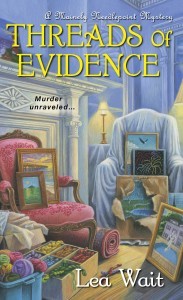 will be released (THREADS OF EVIDENCE, in late August.)
will be released (THREADS OF EVIDENCE, in late August.)
In the past several years I’ve written blogs for Maine Crime Writers and other sites, focusing on what it’s been like to live my dreams: live in Maine full time, and be an author … and the wife of an artist. 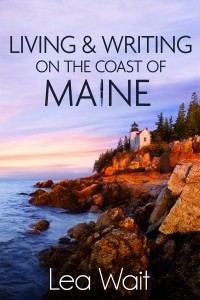
In response to suggestions from a number of you, I’ve now edited, added to, and brought together 32 of the best of these blogs in one place. LIVING AND WRITING ON THE COAST OF MAINE is really a memoir. Starting with a celebration of my anniversary in October, the essays move through Christmas, New Year’s, winter storms, mud season, and on to the joys of Maine summers.
I’ve chosen the selections carefully, based on my most popular blogs, and those that best defined my life now, and sometimes in the past. (We all have backstories.) Warning: they include a fair amount of wry humor.
Because many readers are also writers, or are curious about writers, I’ve also included 25 essay on writing the cosy mystery, doing research, what author signings are really like, how to create a character bible for a book, experiences visiting schools, and other insights into how my life and my writing merge.
Available in both e-book and paperback, I hope you’ll enjoy this peak into living in Maine … and my life.
Lea Wait writes the seven-book Shadows Antique Print Mystery series, starring protagonist Maggie Summer, and the Mainely Needlepoint series, which began with TWISTED THREADS last January. The second in that series, THREADS OF EVIDENCE, will be published in September. She also writes historical novels for ages eight and up set in 19th century Maine.
July 6, 2015
Woman with a Dagger
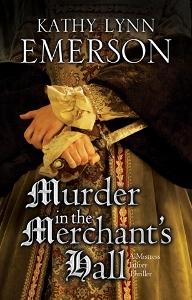 Kathy Lynn Emerson (aka Kaitlyn Dunnett) here, to share some of what I learned in the three-hour Rapier/Dagger/Smallsword Workshop at the Historical Novel Society’s North American Conference in Denver last month. This opportunity came at an extremely good time for me, as I’m about to start writing the third book in my series featuring Mistress Rosamond Jaffrey, Elizabethan sleuth and sometime spy. When I developed the character, in Murder in the Queen’s Wardrobe, I gave her two knives to carry for protection, one sheathed in her boot and the other hidden in a special pocket inside her cloak. Beyond establishing that she knows how to use them, both for stabbing and for throwing, I haven’t had her do much with them in the first two books in the series.
Kathy Lynn Emerson (aka Kaitlyn Dunnett) here, to share some of what I learned in the three-hour Rapier/Dagger/Smallsword Workshop at the Historical Novel Society’s North American Conference in Denver last month. This opportunity came at an extremely good time for me, as I’m about to start writing the third book in my series featuring Mistress Rosamond Jaffrey, Elizabethan sleuth and sometime spy. When I developed the character, in Murder in the Queen’s Wardrobe, I gave her two knives to carry for protection, one sheathed in her boot and the other hidden in a special pocket inside her cloak. Beyond establishing that she knows how to use them, both for stabbing and for throwing, I haven’t had her do much with them in the first two books in the series.
That’s about to change.
The dagger pictured on the cover of the second entry, Murder in the Merchant’s Hall (December 2015), is too large to be one of Rosamond’s concealed weapons, but compared to the daggers used in what is called “rapier and dagger fighting,” it’s not that big, either. This was the style of fighting taught to men in the sixteenth century. I’d read quite a bit about it, but until the workshop I’d never had the chance to see it demonstrated up close and personal, let alone an opportunity to actually handle the blades and practice some of the footwork and wrist movements involved.
Several of the points made by instructor David Blixt seem likely to apply to the situations Rosamond will encounter in the next novel, even though she will probably not engage in two handed fighting herself. What follows are some examples of advice I hope she’ll take to heart.
*Using a blade requires constant training and drills to create muscle memory and dancing is one of the ways men train for fighting with rapier and dagger.
*Force your opponent’s body to bend in the direction it wants to go to throw him off balance.
*Adrenalin is not your friend. You have to keep thinking and be measured and calm.
*Making noise, such as shouting or swearing, while you fight is to remind yourself to breathe. Holding your breath will get you killed.
*Hit with the forearm, not the hand. The hand has too many bones.
*Gloves protect the hands and can knock away a blade.
*Fights are usually very short.
*Left-handed people either learned to fight right-handed or fought left-handed and were mocked. But the left-handed fighter had the advantage of being able to make unexpected moves.
*The dagger (in the off hand) defends and the rapier attacks, but it is possible to seize an opportunity and attack with the dagger.
*In fighting, use joints rather than muscles because muscles tire.
The illustrations above were taken during the workshop. Since I was the one taking them, I’m not in any of them. Probably just as well. Arthritic fingers and ankles do not lend themselves to the necessary moves, although I was able to do enough to get a feel for the process. I also used my iPad to shoot brief videos of parts of the demonstration. I expect these clips will be very useful if Rosamond’s husband Rob, or any other male characters, end up fighting with rapier and dagger in Book Three. Rosamond may even toy with the idea of taking lessons in sword fighting herself and ask Rob to teach her, although I expect she’ll decide to stick to smaller blades.
There will definitely be a scene in which she is practicing throwing her knives at a target.
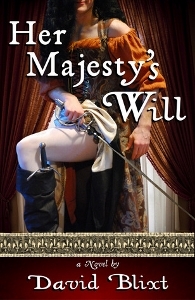 I can’t close without saying a few more words about David Blixt. In addition to being a gifted teacher, he is also a stage actor and a writer. Although I generally avoid reading other people’s fiction when it is set in the sixteenth century, I couldn’t resist buying his Elizabethan novel, Her Majesty’s Will. Picture Shakespeare and Marlowe, before they became playwrights, as two very inept spies.
I can’t close without saying a few more words about David Blixt. In addition to being a gifted teacher, he is also a stage actor and a writer. Although I generally avoid reading other people’s fiction when it is set in the sixteenth century, I couldn’t resist buying his Elizabethan novel, Her Majesty’s Will. Picture Shakespeare and Marlowe, before they became playwrights, as two very inept spies.
Kathy Lynn Emerson/Kaitlyn Dunnett is the author of over fifty books written under several names. She won the Agatha Award in 2008 for best mystery nonfiction for How to Write Killer Historical Mysteries and was an Agatha Award finalist in 2014 in the best mystery short story category for “The Blessing Witch.” Currently she writes the contemporary Liss MacCrimmon Mysteries (Ho-Ho-Homicide, 2014) as Kaitlyn and the historical Mistress Jaffrey Mysteries as Kathy (Murder in the Queen’s Wardrobe, 2015). The latter series is a spin-off from the Face Down series and is set in Elizabethan England.
July 5, 2015
Maine crime writers just wanna have fun
Maureen here, getting some last thoughts in before I head off to Baxter State Park for a few days.
Writing is a funny business. Yes, it’s a business in that we write books and it’s important to sell them. But selling them isn’t primarily why we do this. A bunch of us Maine Crime Writers gathered Saturday to take part in the Belgrade Lakes Fourth of July extravaganza. And yes, we brought books to sell. But as the several hours we spent at the event made clear, a lot of the real fun of this business, besides writing the books, is meeting people and talking about writing and our books.

John Clark, Lea Wait, Kathy Emerson and Dorothy Cannell get ready as the Meet the Maine Crime Writers booth opens for business.
John Clark, Dorothy Cannell, Lea Wait, Kathy Lynn Emerson and Kelly McClymer, all of whom blog on this site, had a grand old time talking to those who stopped to say hi, and I think to a person we’d say that the books we sold during the event were just the gravy on what was a great day.
Speaking for myself, “getting rich” was never really the goal of becoming a published writer. It was also never the goal of my day job, newspaper editor. Both are things I wanted to do since I was 9 or 10 years old. Being from a newspaper family, I knew the journalism gig was never going to make me a lot of money. That prepared me for the reality of being a published writer, I guess. But money — or fame — never was a goal in the first place.
Those who are driven to write do it because they have something they want to say. I’m lucky that there are people out there who are interested in hearing it. I don’t think I’d change the message in order to get more money for it. In fact, I know I wouldn’t.
I could have written for a certain audience, sexed things up more, thrown in some vampires, if they’re still the rage. Maybe written a dystopian vampire-themed BDSM-
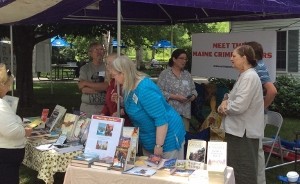
John, Lea, Kathy, Maureen, and Dorothy
tinged mystery thriller about a couple of PI/meth cookers who break all the rules and some heads in order to bring the bad guys (so I guess they aren’t the bad guys? These days, it’s hard to tell) to justice.
But my heart wouldn’t have been in it. I’ve read a lot of bad books in my life, and while they’re all bad in their own way, the lack of heart is obvious.
It was obvious to me from the way my fellow Maine Crime Writers talked about their books and their writing that they had heart Saturday. I think it was obvious, too, to those who stopped by to chat. Some of them even bought books.
July 3, 2015
Weekend Update: July 4-5, 2015
 Next week at Maine Crime Writers there will be posts by Maureen Milliken (Monday), Kathy Lynn Emerson/Kaitlyn Dunnett (Tuesday), Lea Wait (Wednesday), Barb Ross (Thursday) and Susan Vaughan (Friday).
Next week at Maine Crime Writers there will be posts by Maureen Milliken (Monday), Kathy Lynn Emerson/Kaitlyn Dunnett (Tuesday), Lea Wait (Wednesday), Barb Ross (Thursday) and Susan Vaughan (Friday).
In the news department, here’s what’s happening with some of us who blog regularly at Maine Crime Writers:
Don’t forget that today (July 4th) MCW regulars Dorothy Cannell, John Clark, Kaitlyn Dunnett/Kathy Lynn Emerson, Maureen Milliken, and Lea Wait, together with recent guest blogger Kelly McClymer, will be signing books from 11-2 at the Belgrade Lakes 4th of July Festival in Belgrade Lakes, Maine. For those who want to stick around, there’s also a frog jumping contest at 5PM and fireworks once it gets dark.
Here’s a look at our venue, ready and waiting. I’ll try to post pictures later in the weekend to show what it looked like with people crowding around to talk to us and buy our books.
As promised, a few pictures from Belgrade Lakes on the 4th of July.
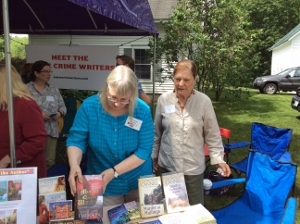
Kathy and Dorothy setting up
A very successful day.
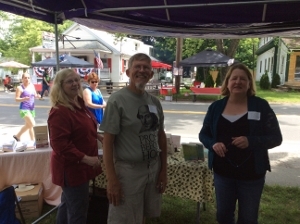
Lea Wait, John Clark, and Kelly McClymer from inside the tent
And a lot of fun, too.
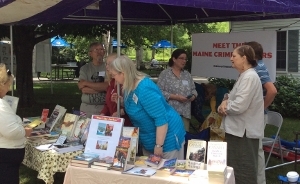
John, Lea, Kathy, Maureen, and Dorothy
Monday, July 6th at 7:00 p.m. Dorothy Cannell and Kate Flora will be at the library in Castine, sharing writing secrets, research stories, and where our characters come from.
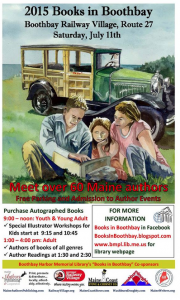 Next Saturday, July 11, is Books in Boothbay, held at the Boothbay Railway Village in Boothbay, Maine. Many, many Maine authors in all genres, including Maine Crime Writers. The morning is for children’s and YA books, the afternoon for the rest of us. (P.S. That means Lea Wait will be there all day — from 9 until 4.) Check here for more details. We’re likely to be giving away fun things, like books and cookie cutters (moose or lobster, anyone?) perhaps even a cool tee shirt from Liberty Graphics.
Next Saturday, July 11, is Books in Boothbay, held at the Boothbay Railway Village in Boothbay, Maine. Many, many Maine authors in all genres, including Maine Crime Writers. The morning is for children’s and YA books, the afternoon for the rest of us. (P.S. That means Lea Wait will be there all day — from 9 until 4.) Check here for more details. We’re likely to be giving away fun things, like books and cookie cutters (moose or lobster, anyone?) perhaps even a cool tee shirt from Liberty Graphics.
What’s your favorite Maine book? We’d love to hear what it is and why you like it. We recently heard from Mainely Murders Bookstore that their customers love the mystery, The Maine Mulch Murder, written by John Clark and Kate Flora’s late mother, A. Carman Clark. Rumor has it there may be another Amy Creighton mystery, The Corpse in the Compost, coming in the next year. If you’d like your own copy of The Maine Mulch Murder, share your favorite Maine book with us…and you could win one.
An invitation to readers of this blog: Do you have news relating to Maine, Crime, or Writing? We’d love to hear from you. Just comment below to share.
And a reminder: If your library, school, or organization is looking for a speaker, we are often available to talk about the writing process, research, where we get our ideas, and other mysteries of the business. Contact Kate Flora: mailto: kateflora@gmail.com
Meet Some Fellow Travelers
John Clark posting today
Regular readers of this blog do so for many reasons. They may be friends with someone who contributes, they may be lovers of mystery or lovers of Maine or they may simply like what we post. Whatever the reason, we’re thrilled to have them stop by. I’m sure that those of us who post here regularly also have blogs we love. As a young adult author, reader and reviewer, I’m always looking for something interesting and stimulating that relates to that genre. I’ve been a follower and pretty much a daily reader of one called YA Outside The Lines (YAOTL) (http://yaoutsidethelines.blogspot.com/) for quite some time. Not only do I get some interesting perspectives on how others approach writing YA fiction, but since the folks blogging there try to have a monthly topic (last month was theme parks), I enjoy how varied the takes are.
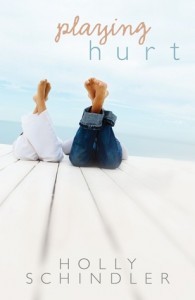
Holly says the sequel is in progress
Since blogs without readers risk becoming like the falling tree in the forest, I wanted to share this favorite of mine with MCW regulars, so I contacted Holly Schindler, the administrator and who has written some really great YA and juvenile fiction (her Playing Hurt is one of my all time favorites) and asked her about doing a profile. As you can see from what follows, she and several of the other members of YAOTL have come through in spades, so read on, consider checking it out regularly and enjoy. One quick reminder: If you’re in Belgrade tomorrow for the 4th of July festivities, make sure to stop by the Maine Crime Writers table. We’ll be there from 11-2.
Who started the blog and why? The blog was started by several authors with MTV books—they enjoyed blogging at the MTV site, but wanted to expand, reach out to some YA authors not necessarily being published by the same company. So YA Outside the Lines was born.
You inherited the blog—how has that gone? I know it’s a lot of work making sure blogs get up in a timely manner, even more so when you’re a writer. I always say I inherited the blog from Jennifer Echols. She was the administrator when I was asked to join. When her writing duties got to be too much, she needed to back away from blogging; I said I’d take over administrative duties. But really, there’s been very little work on my end. I shoot the bloggers reminder emails for their posts, and email the group in order to come up with a monthly “theme.” Then I just get to sit back and enjoy the posts along with everyone else.
How have posters been selected? New bloggers arrive in all sorts of ways. Sometimes they come to me asking to join, sometimes other bloggers at YAOTL will suggest new bloggers, sometimes I ask writers I meet. The only requirement is that they write (and are passionate about) YA lit.
What do you hope the blog accomplishes? I hope it introduces readers to some fabulous YA authors. I hope it provides some sense of community for both our bloggers and readers.
Funniest Post? Most unusual / embarrassing post? So hard to pick! You know, we let it fly at YA Outside the Lines—we talk about our writing journeys (full of bumps in the road), as well as our own teen lives (which are just ripe for crazy stories). You never know what you’re going to read next at YAOTL.
What do a few of your regular bloggers have to say about YA Outside the Lines?
Patty Blount: “OK, my two cents': YAOTL helps me feel like a real author. It’s hard to stay confident in this industry and hanging out with other writers who ‘get it’ makes me feel so much less alone. I’ve never met many of these authors but in a very real sense, they’ve become my family. Nothing Left to Burn is my fourth YA with Sourcebooks Fire and releases on 8/5!”
Jennifer Hubbard: “My first experience with YAOTL was as a reader–so many authors I admired were part of it. I loved the ‘pushing the boundaries of the genre and writing from the heart’ tagline, because that’s what YA is to me: A genre that’s constantly being redefined. Writing with emotional depth. I love reading everyone’s take on the different subjects we tackle. It’s like a mini-anthology every month.
Bio info: Jennifer R. Hubbard is the author of three YA novels, most recently UNTIL IT HURTS TO STOP, and a nonfiction book about writing, LONER IN THE GARRET: A WRITER’S COMPANION.”
Courtney McKinney-Whitaker, author of the historical YA THE LAST SISTER: “I think the best part for me has been “meeting” other writers, if virtually, and getting to know you all through your posts and comments. It makes a lonely job feel less lonely.”
Jody Casella, author of THIN SPACE: “I love being a part of YAOTL. I enjoy the themes each month– coming up with a post and reading the other writers’ approaches to the topics. But what I like most about the group is the sense of community. Writing is such a solitary activity. We’re plugging away, alone, on our laptops, and sometimes it can feel pretty lonely. It’s been nice to meet the people behind the books, people, who it turns out, are a lot like me, with kids and pets and dirty dishes and part-time jobs, people who are juggling writing and promoting, who are working and reworking manuscripts and always dreaming to get more of their stories out into the world. Many of the YAOTLers have become my friends over the past few years.”
Jennifer Salvato Doktorski, author of THE SUMMER AFTER YOU AND ME: “W riting is such a solitary craft that I’m happy to be part of a community of YA authors who understand that the day-to-day business of being an author isn’t always pretty. Some days/weeks/months are more intense than others and during those periods, I become very anti-social, often turning down invitations from friends and putting all non-writing related activities on hold. Reading the blog posts of my fellow YAOTLers, as well as writing my own post once a month, forces me to think about something other than the project I’m currently submerged in and makes me feel connected. I’m always inspired about what others post and often find myself expanding my reading list as well as following their advice about everything from writing a better sentence to decluttering my home.”
Natasha Sinel: “I have been a follower of YAOTL for years (and years and years), and it has been so inspiring to read the heartfelt posts during the long lonely stretch of working toward getting traditionally published.
What I loved about YAOTL as a follower was how different it was from other author blogs. First off, it was one of the first co-op blogs I’d seen, and I loved the monthly topics and how each author had something different to say. It was also different from other blogs because it was about craft and emotion. Most other blogs I followed were about querying, how to get published, etc. I loved seeing the inside look at authors’ writing lives. I remember dreaming of being an author and being a part of a site like YAOTL!
I also loved YAOTL as a follower because it introduced me to authors I wasn’t familiar with (like Holly Schindler whose A BLUE SO DARK really stuck with me). Once I finally got a publishing deal, I approached Holly for a blurb request, and not only did I get the most amazing blurb for THE FIX, Holly invited me to join YAOTL. I have loved writing my YAOTL monthly blog posts about interesting topics where I can dive into my feelings about writing, reading, life, being an author. And I continue to love reading my colleagues’ posts. My debut YA novel THE FIX releases September 1, 2015 from Sky Pony Press.” (NOTE: I’ve read an ARC of This and it’s a great book!)
How do you pick a monthly theme and can you say which have worked the best? I shoot an email to the group mid-month, saying it’s time to throw out some ideas for a theme. Many of our themes have been seasonal, some have been tied strictly to the writing industry. Our best themes have always been those that are the most open-ended (so that bloggers can still find something fresh to say at the end of the month). But we also usually find ways to tie even the most non-writing-sounding theme into our work…
What else would you like MCW readers to know about the blog? Just that we’re always looking to interact with new readers. Be sure to follow us at yaoutsidethelines.blogspot.com. If you’d like to suggest a monthly theme you’d like us to write about, you can always shoot me a message at writehollyschindler (at) yahoo (dot) com.
About Holly Schindler, YA Outside the Lines Administrator:
Holly Schindler is the author of four traditionally published books; her work has received starred reviews in Booklist and Publishers Weekly, has won silver and gold medals in ForeWord Reviews Book of the Year and the IPPY Awards, respectively, has been featured on Booklist’s Best First Novels for Youth and School Library Journal’s What’s Hot in YA, and has been a PW Pick of the Week. She recently became a hybrid author; FIFTH AVENUE FIDOS (contemporary adult humor) is her first independently published book. She is owned by a Pekingese named Jake and can be found working on her next book—PLAY IT AGAIN, the sequel to her YA romance PLAYING HURT—in her hometown of Springfield, Missouri. She can also be found at hollyschindler.com, @holly_schindler, and facebook.com/HollySchindlerAuthor For sneak peeks, giveaways, news, writing tips, and more, subscribe to her newsletter: tinyletter.com/hollyschindler.

